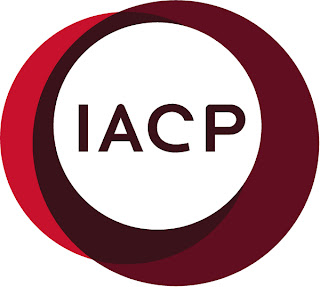Check out Melissa De Leon´s latest Global Food Reports on Global Voices which include valuable links to food websites and podcasts from Malaysia, Sweden, Spain, and Venezuela among others.
Sunday, July 30, 2006
Global Food Reports
Check out Melissa De Leon´s latest Global Food Reports on Global Voices which include valuable links to food websites and podcasts from Malaysia, Sweden, Spain, and Venezuela among others.
Frankfurt Book Fair – October 4-8, 2006
 For the first time an international exhibition of food and wine books will take place at the Frankfurt Book Fair. There will be 1500 books of the last 10 years, from 70 countries. The exhibition takes place on the Gourmand World Cookbook Awards stand, with 150 m2, and shows the winners of last year awards, as well as a selection of winners from the past years.
For the first time an international exhibition of food and wine books will take place at the Frankfurt Book Fair. There will be 1500 books of the last 10 years, from 70 countries. The exhibition takes place on the Gourmand World Cookbook Awards stand, with 150 m2, and shows the winners of last year awards, as well as a selection of winners from the past years.Since the announcement of this exhibition, authors and publishers of food and wine books have communicated to Gourmand that they will visit the Frankfurt Book Fair, many for the first time. Gourmand maintains a list of these visitors. Many meetings have been already arranged, and there is intense activity.
The “Gourmand World Cookbook Awards” were created at the Frankfurt Book Fair in 1995 to honour those who cook and drink with words. Since then the sector has had amazing growth, with the help of television, and has become glamourous, with stars in many countries. The number of titles published each year has at least doubled in 10 years in most countries. For instance Sweden publishes now the same number of titles as France ten years ago, with a population 6 times smaller. France has multiplied in 10 years its production by nearly 3 times. Now Asia and other markets are developing rapidly.
The “Gourmand World Cookbook Awards” have become the “Oscars” of the sector. They have taken place in Germany, France, Spain, Sweden, and for the first time in May 2006 in Asia, in Kuala Lumpur, Malaysia. So Gourmand is very pleased to come back to the Frankfurt Book Fair this year, and honour there again its past winners with this exhibition.
For Information visit the Gourmand website or contact:
Edouard Cointreau, President, Founder
Pintor Rosales, 36
28008 Madrid
Spain
Tel: +34 91 541 67 68 Fax: +34 91 541 68 21
E-Mail: edouard@gourmandbooks.com
Bo Masser, Secretary of the Jury
Brandtvagen 5 A
SE-712 32 Hellefors
Sweden
Tel: +46 70 6677 388
E-Mail: bo@massers.se
www.cookbookfair.com
Tuesday, July 18, 2006
Dia de las Ciruelas - Slow Food Laboratorio del Gusto
 The invitation had come for the 51st Laboratorio del Gusto in Mexico City and I had quickly accepted. As an expatriate “foodie” the invitation program was irresistible. Picking plums and preparing recipes with Chef Olivier Lachevre, sipping organic Veracruzan coffee, followed by a Carne Asada luncheon prepared by our host Sergio Ynurrigarro in the gardens of the House of the Sun and Moon. All that was needed were directions and Sergio’s encouraging words “just keep driving until you see the Slow Food posters and then turn right”.
The invitation had come for the 51st Laboratorio del Gusto in Mexico City and I had quickly accepted. As an expatriate “foodie” the invitation program was irresistible. Picking plums and preparing recipes with Chef Olivier Lachevre, sipping organic Veracruzan coffee, followed by a Carne Asada luncheon prepared by our host Sergio Ynurrigarro in the gardens of the House of the Sun and Moon. All that was needed were directions and Sergio’s encouraging words “just keep driving until you see the Slow Food posters and then turn right”.As we left the valley floor of the city and slowly drove up the mountainside on the Camino al Desierto de los Leones my friends and I anxiously scanned every corner for the non-existent street signs and realized it was the road markers we would need. Km. 30 was our destination and we were only at Km. 18 when the grainy hail and rain started to fall. It was Sergio with umbrella and hand signs that finally welcomed us. The cafe de olla was warm, sweet and dark a perfect antidote to the chill breezes of the overcast morning.
As our fellow foodie compatriots arrived, we were delighted by the tour of the orchards and specially the palapa where a 6 foot parilla ladened with scallions, tomatoes, chiles, and avocados were ready and waiting for Sergio to begin, but not until we gathered at the 2nd terrace meeting room/palapa did we begin with the fresh plums and their transformation into jam, jelly and the flavoring for plum wine infused with Mezcal.
Aromas of sweetened plums, sharp onions, coriander, grilling steak had our primal emotions stirring. As a group, we took the cobbled path to the grill and watched as the gnarled hands of an expert tortilla maker took the blue corn masa, formed, pressed and then quickly threw the tortilla on the grill to cook. Sharp pungent flavors, green and red chile salsas, the cooling unctuous flavor of guacamole, carne asada and the scent of mountain chill, culinary bliss !
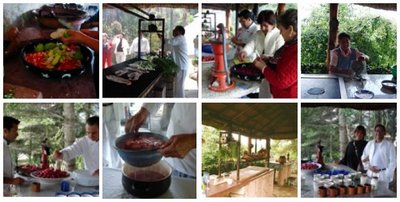
Our Laboratorio del Gusto was ending but not the memories of taste of El Dia de las Ciruelas.
Ruth Alegría
Mexico
Saturday, July 15, 2006
Madrid Fusion 2006 goes to New York City
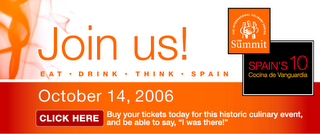
The French Culinary Institute in New York City, winner of IACP´s School of the Year Award 2006, is celebrating it´s new home, the International Culinary Center, this coming October. And what a way to celebrate! During two days, the new center will be hosting culinary demostrations by 10 of the most prominent Spanish chefs, including Ferran Adriá, Juan Mari Arzak and Martín Berasátegui. If you missed Madrid Fusión 2006, now is your chance for this unique experience.
For more information visit Spain´s 10.
Wednesday, July 12, 2006
Projeto Mandioca
 Since October 2002, children attending public schools in the city of Rio de Janeiro are having the opportunity to learn more about Brazil’s food history and habits through “Projeto Mandioca”, a project developed by Teresa Corção, chef/owner of restaurant “O Navegador”, in downtown Rio.
Since October 2002, children attending public schools in the city of Rio de Janeiro are having the opportunity to learn more about Brazil’s food history and habits through “Projeto Mandioca”, a project developed by Teresa Corção, chef/owner of restaurant “O Navegador”, in downtown Rio.For over 25 years in food business, Teresa believes that the project will help children to better appreciate their own families’ culinary treasures, as well as to enhance their interests for the products, tastes and aromas of the Brazilian culinary.
“Manioc was and still is Brazil’s bread since the times when the Portuguese colonizers had not yet arrived to these lands.
As a major source of carbs, manioc provides the energy needed to face hard works, and can be considered as the “blood of Brazilian land”, reminds Teresa.
The real importance of this product is mostly unknown, although it is very much used and appreciated in our daily meals. In the very first contacts that the discoverer of Brazil – Pedro Alvares Cabral – had with the Indians Tupiniquins, in the south of the state of Bahia, he was introduced to manioc, a native product of those yet unexplored lands.
To our native Amerindians, manioc was the most important ingredient in the preparation of different meals such as porridges, cakes, breads (pirão, beiju, mingau ,paçoca).
As the European wheat was not suitable to the climate of the newly discovered lands, the colonizer had to get used to manioc, a root so much appreciated nowadays throughout the world.
No other product is as much Brazilian and has such an importance as manioc.
With this in mind, and working together with a team of experts Teresa decided to launch her project. Through workshops in public schools, children learn the importance of manioc during informal classes, theater and hands on cooking demonstration, learning how to prepare tapioca and other traditional Brazilian dishes. This way they strengthen their relationship with their Brazilian identity.
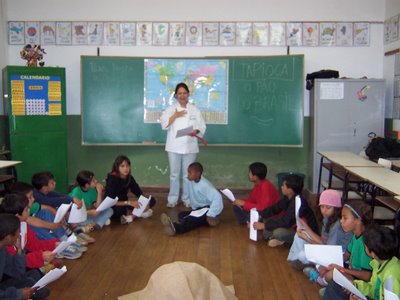
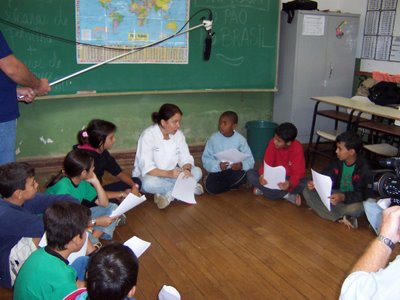
Projeto Mandioca has been supported by EMBRAPA - Empresa Brasileira de Pesquisa Agropecuária (Brazilian Agroindustry Research Company).
This organization maintains Projeto Mandioca permanently updated in whatever concerns manioc in Brazil and worldwide, while improving its research studies on the subject.
VIVA A MANDIOCA !
Did you know that...
1-Over 4 million Brazilians depend directly or indirectly of manioc culture
2- The very first Brazilian Constitution was called “Constituição da Mandioca” that is Manioc Constitution, thus showing how much manioc symbolizes to our national identity
3-Manioc sediment (fecula) is a powerful starch very much used in industry such as pharmaceutical, textile, pulp and paper industries besides many different uses in food industry
4-Manioc leaves have high concentration of calcium, iron, vitamin A and proteins. A preparation with the dehydrated and powdered leaves is being distributed to low-income population in the country.
The Ministry of Health as the most important ally against sub nutrition is considering this action.
5- The state of Pará is the most important producer of industrialized manioc meal while the state of Bahia is the larger artisan producer of manioc meal.
6-There is a project going on at the Deputy Chamber, which tries to include or substitute part of wheat flour for manioc flour in the preparation of daily bread and other preparations. Embrapa is researching if this would improve the protein values on the bread presently consumed in Brazil
7-Nigeria is the world largest manioc producer; our Portuguese colonizers took this native Brazilian root there
8-Thailand, which also received the root from our Portuguese colonizers, is the largest worldwide exporter of manioc starch mostly to European Union.
It is interesting to notice that manioc is not used there as food.
9-Brazil has a surplus of manioc starch (fecula), which has rendered useless because its exports are not competitive in the European Union.
Thailand, which is the largest exporter, enjoys a zero tax bracket, while our product is charged by a tax above 20%.
10- Brazil produces 23 million tons manioc behind only to Nigeria whose production is of 34 million tons.
Projeto Mandioca
Teresa Corção
IACP Country Coordinator
Brazil
Sunday, July 09, 2006
Kyoto's Nishiki Market
 Nishiki Market is in the heart of the historical city of Kyoto. It is open to the public and you will find most of Kyoto`s famous food products here from yuba (soy milk skin) to tsukemono (pickles) to ocha (tea). The Aritsugu knife shop offers more than a huge selection of knives but also a variety of kitchen tools. A new addition to the market is a standing bar where you can have fresh oysters and wine. Do not miss the Photo Tour and Yukari's list of favorite shops.
Nishiki Market is in the heart of the historical city of Kyoto. It is open to the public and you will find most of Kyoto`s famous food products here from yuba (soy milk skin) to tsukemono (pickles) to ocha (tea). The Aritsugu knife shop offers more than a huge selection of knives but also a variety of kitchen tools. A new addition to the market is a standing bar where you can have fresh oysters and wine. Do not miss the Photo Tour and Yukari's list of favorite shops.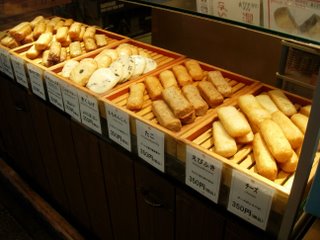


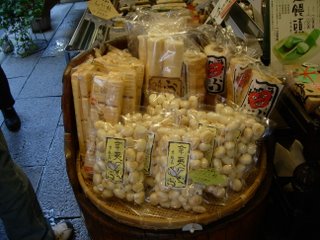
by Yukari Pratt
Tokyo, Japan
Friday, July 07, 2006
On the Trail from Penang to Kuala Lumpur
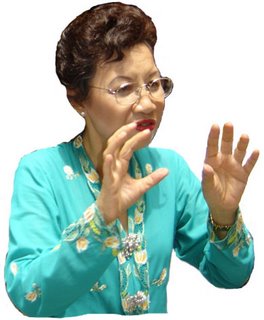 Profile: Florence Tan, Celebrated and Celebrity Chef
Profile: Florence Tan, Celebrated and Celebrity Chefby Scott Givot, IACP Board Director
Photography by Elena Hernández
How did I become so blessed?
On a recent journey to Malaysia, a country named by the Malaysian Tourist Board as "the Real Asia", I was afforded the opportunity and luxury of exploring this diverse and culinary rich culture under the tutelage of a true pro. She is renowned for her talents, both through cook book writing and television appearances and still it is her warm and generous spirit of sharing the memories and knowledge of the Malaccan Nyonya (Straits Chinese) family cooking that has left an indelible impression in my heart and on my palate. Everywhere we were together, she is recognized and admired, by young and old and forever humble in their presence. The great chefs of Malaysia treat her like a goddess, endearingly and with admiration.
Nyonya cuisine is authentic Malaysian cuisine. It represents fusion cooking in the truest sense of the word. It is in part Chinese with the incorporation of Malay herbs, Indian spices and prepared in a Malaysian style in an Indian curry pot or Chinese wok. The dishes are enhanced with nuances of fragrant leaves, flowers and herbs along with an intense undercurrent of chili and coconut milk.

In her book, Secrets of Nyonya Cooking, it is explained that "the Peranakan kitchen is the domain of womenfolk, with Mother and Bibik orchestrating the symphony of meals to be served in a large household. Bibik is the commanding presence no Peranakan kitchen is complete without. Her culinary expertise is unquestionable, her repertoire of recipes inexhaustive. She demands the very best from kitchen retainers and cooks. As she flits from flaming wok to boiling cauldron, she sniffs and tastes like a five-star chef. Her culinary standards must never be challenged or disputed."
Thus, I must concur. Whether it was a formal State lunch in the auspices of a preserved home of antiquity or amongst the 50 stations of a fantasy land of Malaysian food culture on the lawn of Prime Minister Abdullah Ahmad Badawi's palace, Florence affectionately and painstakingly led me on a journey that I shall never for get in my life. I tasted everything she wanted me to sample and afterwards I received a small anecdotal history about each dish. Fortunately she requested very small portions in consideration of the monumental consumption task ahead of me.
The following is her recipe for Peanut Sauce, also from her book, Secrets of Nyonya Cooking, used in her delicious Chicken Satay recipe:
Peanut Sauce
150 ml/ 3/8 cup cooking oil
1 litre/ 4 cups coconut milk, extracted from 350 grams/ 3 1/2 cups grated coconut and 1 litre/ 4 cups water
350 grams/ 12 1/2 ounces *bilimbi (belimbing buluh), cut into 1-cm/ 1/2 inch sticks and boiled for 1 minute to remove a bit of its sourness
300 grams/ 1 3/4 cups finely chopped pineapple
300 grams/ 2 1/2 cups roasted peanuts, coarsely pounded
1 1/2 rounded tablespoons salt
220 grams/ 1 cup sugar
Finely Ground Paste
25 dried chilies, soaked in water and drained
28 shallots, peeled
2.5 cm/ 1 inch galangal, peeled
1 tablespoon crushed dried shrimp paste
Method
1. Heat the cooking oil and fry finely ground paste until fragrant. Stir in coconut milk and bring to a boil.
2. Add the bilimbi and pineapple, cook for 6 minutes. Stir in peanuts and season with salt and sugar.
3. Simmer for 5-10 minutes until the sauce thickens, stirring constantly.
*For those who may not be familiar with "bilimbi", as I was not prior to my adventure with Florence, here is an explanation.
A friend of mine in Oslo has used lemon or tamarind as substitute souring agent. It's not quite the same, however, may be far more accessible to those in the Western world.
For more on Nyonya Cuisine in SPANISH, visit El Amor por la Cocina.
Blogging & Podcasting
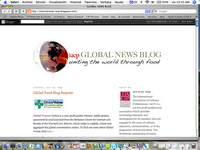 Food unites the world and so does the internet. Today, there are incredible tools available to communicate and one of our favorite ones is blogging. Some of you who are visiting for the first time, may want to learn more about the world of blogs. To begin with, Wikipedia defines a weblog, which is usually shortened to blog, as a website where regular entries are made (such as in a journal or diary) and presented in reverse chronological order. Blogs often offer commentary or news on a particular subject, such as food, politics, or local news; some function as more personal online diaries. A typical blog combines text, images, and links to other blogs, web pages, and other media related to its topic. Most blogs are primarily textual although many focus on photographs, videos or audio. The word blog can also be used as a verb, meaning adding an entry to a blog.
Food unites the world and so does the internet. Today, there are incredible tools available to communicate and one of our favorite ones is blogging. Some of you who are visiting for the first time, may want to learn more about the world of blogs. To begin with, Wikipedia defines a weblog, which is usually shortened to blog, as a website where regular entries are made (such as in a journal or diary) and presented in reverse chronological order. Blogs often offer commentary or news on a particular subject, such as food, politics, or local news; some function as more personal online diaries. A typical blog combines text, images, and links to other blogs, web pages, and other media related to its topic. Most blogs are primarily textual although many focus on photographs, videos or audio. The word blog can also be used as a verb, meaning adding an entry to a blog.Another great tool that is becoming more and more popular is the podcast, an audio file that you can either download to your computer or hear online. According to Wikipedia , Podcasting is the method of distributing multimedia files, such as audio programs or music videos, over the Internet using either the RSS or Atom syndication formats, for playback on mobile devices and personal computers. The term podcast, like 'radio', can mean both the content and the method of delivery. The host or author of a podcast is often called a podcaster. Podcasters' web sites may also offer direct download or streaming of their files; a podcast however is distinguished by its ability to be downloaded automatically using software capable of reading RSS or Atom feeds. Usually a podcast features one type of 'show', with new episodes released either sporadically or at planned intervals such as daily or weekly. In addition, there are podcast networks that feature multiple shows on the same feed. You can learn by clicking here
So, to show you what´s a podcast like, I chose E-Gullet Society Executive Director Steven Shaw´s interview with IACP Board member Darra Goldstein on the Feeding Desire Exhibition at the Cooper-Hewitt National Design Museum In New York. Please click on the image to start enjoying.

by Elena Hernandez
International Committee Chair
Tuesday, July 04, 2006
Global Food Blog Reports
Global Voices Online is a non-profit global citizens’ media project, sponsored by and launched from the Berkman Center for Internet and Society at the Harvard Law School, which seeks to amplify, curate and aggregate the global conversation online. To find out more about Global Voices click here. -
Chef Melissa De Leon, from The Cooking Diva and IACP - Panama Chapter member, is the author of the weekly Global Food Blog Reports.If you are curious about what the world is cooking and eating, head over to Global Voices and enjoy her recent contributions:
- Global Food Blog Report # 20
- Global Food Blog Report #21
- Global Food Blog Report #22
- Global Food Blog Report #23
Sunday, July 02, 2006
Understanding Food & Culture
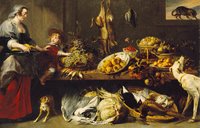 Ken Rubin, IACP´s CCP Committe Vice-Chair is the Editor of Chefs.com, a website that contains recipes, articles, and cooking tips from some of the best chefs around. I stumbled upon this site through a link and found interesting content that I wanted to use for this blog, so I wrote them asking permission to do so. I was very surprised when Ken wrote back saying we´d met numerous times during IACP conventions, and that I was welcome to link to his site. That´s an example of how IACP manages to "unite the World though food".
Ken Rubin, IACP´s CCP Committe Vice-Chair is the Editor of Chefs.com, a website that contains recipes, articles, and cooking tips from some of the best chefs around. I stumbled upon this site through a link and found interesting content that I wanted to use for this blog, so I wrote them asking permission to do so. I was very surprised when Ken wrote back saying we´d met numerous times during IACP conventions, and that I was welcome to link to his site. That´s an example of how IACP manages to "unite the World though food".In one of his articles, Understanding Food and Culture , we learn how ..."chefs must strive to be competent in both the hands-on practicalities of food production and have a thorough understanding of where foods come from, how they are prepared in their own contexts, and why certain techniques are used over others. Traditionally chefs merely prepared food, now chefs are expected to articulate the origins, histories, and meanings of the dishes they prepare. Now chefs can actually interpret cuisines, not just cook foods..."
To read the complete article, click here .
Subscribe to:
Posts (Atom)

